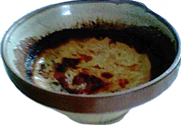
French cuisine is the cooking traditions and practices from France. In the 14th century, Guillaume Tirel, a court chef known as "Taillevent", wrote Le Viandier, one of the earliest recipe collections of medieval France. In the 17th century, chefs François Pierre La Varenne and Marie-Antoine Carême spearheaded movements that shifted French cooking away from its foreign influences and developed France's own indigenous style.

Blancmange is a sweet dessert popular throughout Europe commonly made with milk or cream and sugar thickened with rice flour, gelatin, corn starch, or Irish moss, and often flavoured with almonds.
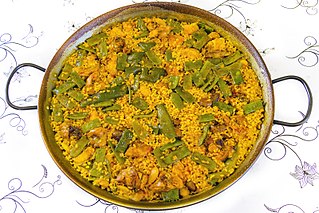
Paella is a rice dish originally from the Valencian Community. Paella is regarded as one of the community's identifying symbols. It is one of the best-known dishes in Spanish cuisine.

An omelette is a dish made from eggs, fried with butter or oil in a frying pan. It is a common practice for the omelette to be folded around fillings such as chives, vegetables, mushrooms, meat, cheese, onions or some combination of the above. Whole eggs or egg whites are often beaten with a small amount of milk, cream, or water.

Gumbo is a stew popular in the U.S. state of Louisiana, and is the official state cuisine. Gumbo consists primarily of a strongly flavored stock, meat or shellfish, a thickener, and the Creole "holy trinity" – celery, bell peppers, and onions. Gumbo is often categorized by the type of thickener used, whether okra or filé powder.

Jambalaya is an American Creole and Cajun rice dish of French, African, and Spanish influence, consisting mainly of meat and vegetables mixed with rice.
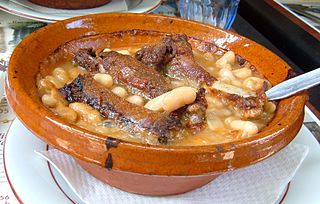
Cassoulet is a rich, slow-cooked stew originating in southern France. The food writer Elizabeth David described it as "that sumptuous amalgamation of haricot beans, sausage, pork, mutton and preserved goose, aromatically spiced with garlic and herbs". It originated in the town of Castelnaudary in the Aude department in the Occitanie region. Variants of the dish are local to other towns and cities in the Aude.
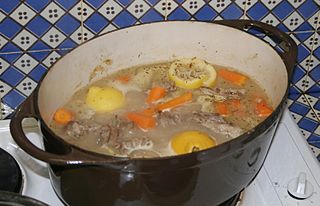
Blanquette de veau is a French veal stew. In the classic version of the dish the meat is simmered in a white stock and served in a sauce velouté enriched with cream and egg. It is among the most popular meat dishes in France.
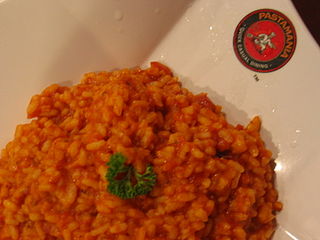
Risotto is an Italian rice dish cooked with broth until it reaches a creamy consistency. The broth can be derived from meat, fish, or vegetables. Many types of risotto contain butter, onion, white wine, and Parmesan cheese. It is one of the most common ways of cooking rice in Italy. Saffron was originally used for flavour and its signature yellow colour.

Rice pudding is a dish made from rice mixed with water or milk and other ingredients such as cinnamon, vanilla, and raisins.

Castelnaudary is a commune in the Aude department in the Occitanie region of southern France. It is located in the former province of the Lauragais and famous for cassoulet of which it claims to be the world capital, and of which it is a major producer.

A lardon, also spelled lardoon, is a small strip or cube of fatty bacon, or pork fat, used in a wide variety of cuisines to flavor savory food and salads. In French cuisine, lardons are also used for larding, by threading them with a needle into meats that are to be braised or roasted. Lardons are not normally smoked, and they are made from pork that has been cured with salt.

Beef bourguignon or bœuf bourguignon, also called beef Burgundy, and bœuf à la Bourguignonne, is a French beef stew braised in red wine, often red Burgundy, and beef stock, typically flavored with carrots, onions, garlic, and a bouquet garni, and garnished with pearl onions, mushrooms, and bacon. A similar dish using a piece of braised beef with the same garnish is pièce de bœuf à la bourguignonne.

Jollof, or jollofrice, is a rice dish from West Africa. The dish is typically made with long-grain rice, tomatoes, chilies, onions, spices, and sometimes other vegetables and/or meat in a single pot, although its ingredients and preparation methods vary across different regions. The dish's origins are traced to the Senegambian region.

The cuisine of Senegal is a West African cuisine that derives from the nation's many ethnic groups, the largest being the Wolof. Islam, which first embraced the region in the 11th century, also plays a role in the cuisine. Senegal was a colony of France until 1960. From the time of its colonization, emigrants have brought Senegalese cuisine to many other regions.

Arroz a la valenciana or Valencian rice is a name for a multitude of rice dishes from diverse cuisines of the world, which originate from the rice-cooking tradition of the Valencian Community, in eastern Spain.

Tripes à la mode de Caen is a traditional dish of the cuisine of Normandy, France.

Arroz con gandules is a combination of rice, pigeon peas, and pork, cooked in the same pot with sofrito. This is Puerto Rico's national dish along with roasted pork.
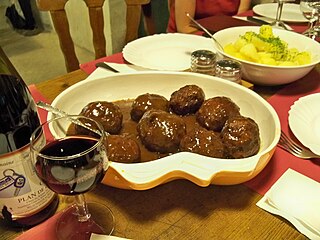
The boulet à la liégeoise is a Belgian dish made from balls of mixed minced pork and beef in a sweet-sour sauce. As its name indicates, the dish comes from the city of Liège in Wallonia.
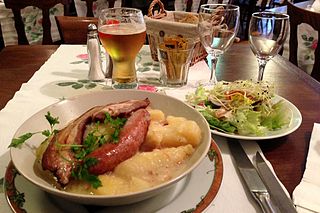
Cacasse à cul nu is a dish originating from the Ardennes department of France. It is made in a Dutch oven with potatoes and onions, and is often served with bacon or smoked sausage. The dish was originally flavoured by rubbing the Dutch oven with bacon before cooking, but was not served with meat, hence the term "nu" (transl. nude). The terms culottée or habillée (transl. dressed) are often included to indicate that the dish contains meat.
